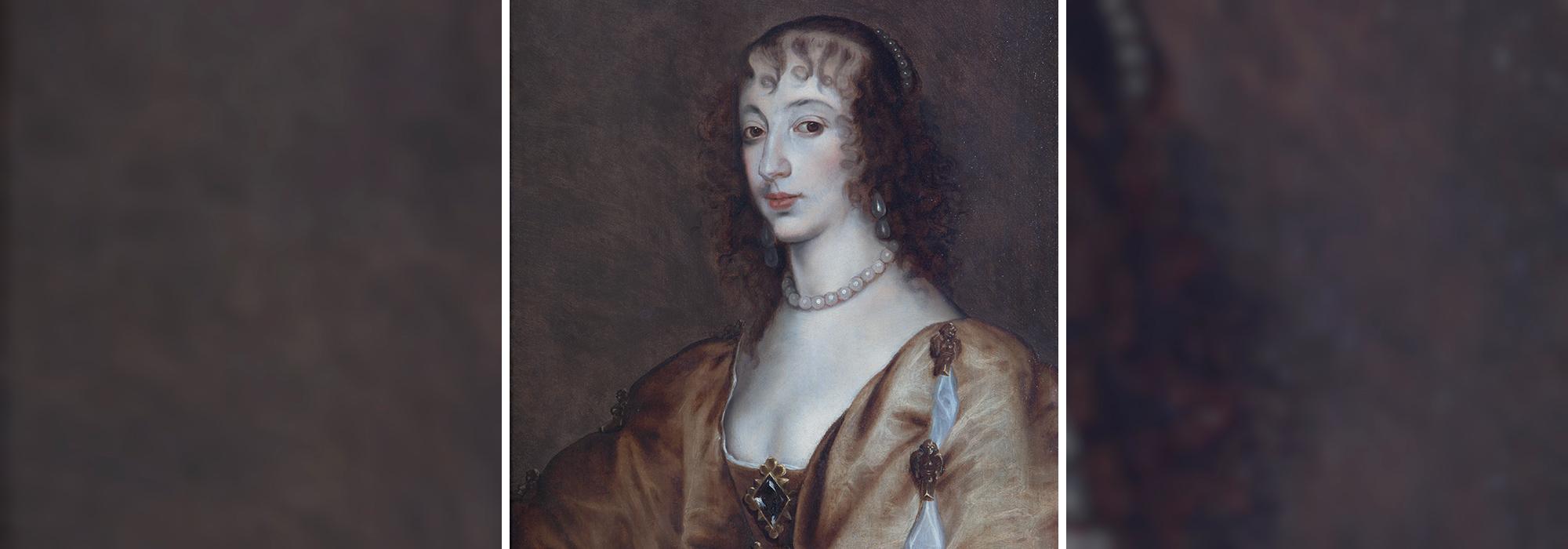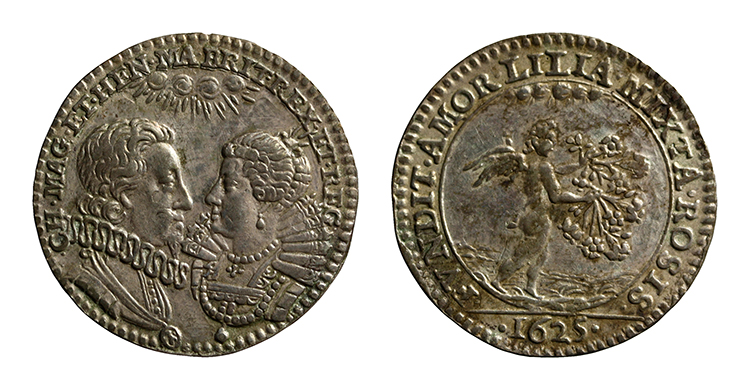
Queen Henrietta Maria
Several queens have visited Merton over the years, but only one settled in for a long stay. Henrietta Maria came to join her husband Charles I when he made Oxford his capital during the English Civil War. Born in the Louvre in 1609, just six months before the assassination of her father Henry IV of France, she grew up mostly at St Germain in the fashionable palace and gardens built by her father’s estranged wife, Margaret of France. A childhood amidst political turmoil, relieved alternately by semi-rural retreat and spectacular court occasions, perhaps prepared her for her eventful life in England.

Henrietta’s marriage to Charles, celebrated in 1625, did not start well. They married on the rebound after Charles’s humiliatingly unsuccessful trip to Spain – in disguise – to woo a Spanish princess. A match across the sharp confessional divisions of the age posed problems. The Thirty Years War, in which Catholics fought Protestants in Germany and beyond, had begun in 1618. Charles could guarantee his wife’s freedom to worship as she chose, but not the toleration for English Catholics that he had secretly promised to pursue. Rivalries between English courtiers and her French attendants, made worse by the controlling instincts of Charles’s favourite the Duke of Buckingham, ended in the expulsion of most of the French in 1626. War between England and France broke out in 1627 over English support for France’s Protestant minority, then in revolt against the queen’s brother, King Louis XIII. Relations between king and queen were visibly frosty.
The assassination of Buckingham in 1628 saved the marriage. Charles and Henrietta Maria found solace together and eight children were born between 1629 and 1644, a family famously celebrated in the portraits of Van Dyck. She developed into a discerning patron of the arts, an enthusiastic developer of houses and gardens, a confident participant in court politics and a committed patron of the Catholic cause in England. King and queen commissioned and participated in court masques that held up their mutual love as a model for the harmony of a wise king and his ordered realm. As tensions grew over Charles’s religious and fiscal policies across his three kingdoms, tensions that would lead in 1637 into a revolt in Scotland, his more anxious subjects saw in such productions evidence not of harmony, but of papist conspiracy at the heart of the court and of the queen at its head. Her elaborate baroque chapel, built by Inigo Jones at Somerset House, her cultivation of continental sacred music, her squad of French Capuchin priests, her encouragement of noble lady converts to Rome and her welcome to papal agents at court all fitted the picture.
As Charles turned reluctantly to his English Parliament to resolve the deepening crisis, criticism of the queen mounted. It was in part fear for her safety that led them to leave London in January 1642 and soon afterwards she crossed to Holland. She was both escorting her daughter to a marriage into the House of Orange and looking for support for her husband’s cause. Early in 1643, she sailed to Bridlington and set herself up at York, helping to direct the royal armies in the north, but her aim was always to re-join the king, who had made Oxford his base and Christ Church his home. Already in February she was writing to him, ‘I am in the greatest impatience in the world to join you’.
By mid-March 1643, rooms at Merton were being prepared for the queen and a route cleared between their host colleges so that king and queen could readily meet. She finally arrived on 14 July, entering the city by coach. There were speeches of welcome and the university authorities presented the queen with gloves and books of poems. Then she walked with Charles from Christ Church through one of the Canon’s gardens and ‘Corpus Christi backeside’ to Merton, where she settled into the Warden’s Lodgings at the junction of Front Quad and Fellows’ Quad. These were conveniently vacant as the Warden, Nathaniel Brent, had fled to London and sided with Parliament, which was by then busy trying to impeach the queen as well as to besiege her husband.
Henrietta Maria already knew Oxford. When she and Charles visited in August 1636, four-year-old Anthony Wood, the great chronicler of 17th-century Oxford who grew up in Postmasters Hall, saw them and remembered it for the rest of his life. Indeed, she already knew Merton, for Warden Brent had entertained the royal couple in 1629. Welcomed to the College with an oration by James Marsh, a long-serving fellow, they spent an hour in the long gallery that stretched from Brent’s lodgings along the top of Fellows’ Quad, enjoying afternoon sweetmeats.
She made her bedroom in Brent’s dining room, now the Breakfast Room, accessible from the stately carved staircase that Brent had just had built, while her entourage occupied the Queen’s Room over the Fitzjames Arch and adjoining areas. They included several servants who died at Oxford and were buried in the College Chapel – Richard North, Ellis Roberts, Mary Skevington – and the widows of aristocratic royalist captains, such as Lady Cobham and the Countess of Northampton. The Chapel hosted her Catholic services and at least one fellow, Dr John Greaves, the Savilian Professor of Astronomy, was later accused of spending far too much time with her Capuchin confessors.
From Oxford the queen played an ongoing role in the royalist war effort. The king came to see her at Merton most afternoons and leading courtiers, such as the Earl of Holland, joined them there. She stirred plots in Scotland and Ireland, encouraged the Marquess of Newcastle, the commander in the north with whom she had worked at York, and kept up communications with Cardinal Mazarin, chief minister in France. At length the tightening parliamentarian siege and the impending birth of her last child made Oxford unsafe and in April 1644 she left for the West Country and headed on to France. There she and her small exile court sought help for Charles from any quarter they could think of – France, Lorraine, Holland, Denmark, Ireland, Scotland, Rome – but all in vain. Horrified by her husband’s execution in 1649, she wore black from then on. Religious and political divisions within the royalist party hindered her attempts to help her son regain his throne and she played little part in his restoration in 1660, though she celebrated it with a Te Deum, bonfires and a ball.
By the time she followed her son to England she was, as Samuel Pepys ungallantly put it, ‘a very little plain old woman’. Yet she refurbished Somerset House – Pepys did admit that it was ‘most stately and nobly furnished’ – re-joined court life and resumed her promotion of courtly Catholicism. After a few years, vexed by the English climate, she returned to France, where she died in 1669, surrounded by servants who had been with her for three or four decades. Laid to rest after a state funeral at St Denis, she had proved herself remarkable through extraordinary times. For Caroline Hibbard, in the language of the 21st-century historian, she was ‘a strong-minded, assertive, and focused political actor’. For Bishop Bossuet, in the more elevated and partisan tones of the 17th-century funeral sermon, with ‘so many great and lovable qualities’, ‘a spirit and a heart yet higher than her birth’, ‘an incredible dexterity in dealing with the most delicate affairs’, with ‘the zeal with which she burned for the re-establishment’ of the faith of ‘the Catholics of England, of whom she was the faithful protectress’ and with a deathbed faith ‘simple … solid … tranquil’, she was ‘the worthy object of the admiration of two great realms’.
Steven Gunn, Fellow and Tutor in History